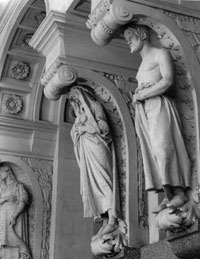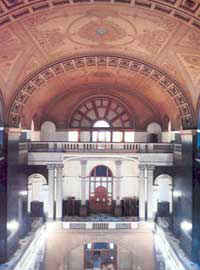The Great Hall of the Old Suffolk County Court House

The Old Suffolk County Court House's Great Hall was filled wit white marble and polished granite when it was completed in 1894. There were paintings containing images of the law and allegorical figures beneath the second story balcony. The Hall itself was designed as a passageway for city inhabitants, a thoroughfare where people could walk directly from Scollay Square up a small street to Pemberton Square, on through the Court House itself via the Great Hall, coming out the door onto Somerset Street, and facing straight ahead along Ashburton Place to the then newly expanded Massachusetts State House. It was a connector between the State House and then a bustling commercial area, between the governmental and the financial areas.
The decorator for the Great Hall was Albert Haberstroh, of the Boston firm of L. Haberstoh & Son. Haberstroh was also the decorator for the B. F. Keiths Memorial Theater, later known as the Savoy and the Opera House on Washington Street. The Great Hall of the Court House features symbols of Suffolk County in the entrance vestibule and decorative paintings on the barrel vaulted ceiling and on the walls.[1] High up on the western walls are the words "Lex" and "Justicia" in cartouches of gold on dark blue backgrounds. The mostly unadorned walls give way to a gold on gold ceiling featuring classical patterns and the Great Seal of Massachusetts.

Domingo Mora (1840-1911) sculpted the allegorical figures lining the Hall. A native of Spain, Mora was known for his allegorical figures and murals. Among his other notable works was the four paneled mural series for the Palace Theater in Los Angeles done in 1911. Mora's series of sixteen life-sized figures for the Great Hall represents many of the virtues, like justice and equity, that should be present in the legal system.
Also in the Great Hall is a freestanding bronze statue of the great Massachusetts attorney Rufus Choate. The artist was the famous American sculptor Daniel Chester French. Other works by French include the Concord Minuteman statue (1875) and the majestic seated statue of Abraham Lincoln in Washington DC's Lincoln Memorial (1913). The City of Boston, with the help of funding from George B. Hyde, erected the Choate Statue. [2]
The magazine American Art Illustrated for November, 1886, published when the Court House was still in the planning stages, featured comments expressing the hope that the new building would be decorated extravagantly by muralists and sculptors, "as it is done in France." [3] This suggests that plans called for the Great Hall to be adorned with many more paintings and sculptures than have ever been present.[4] The Court House was to have been heavily ornamented and decorated like the other major High Victorian buildings in Boston, the Boston Public Library, the State House Expansion, and Trinity Church, but that goal was never achieved.
Footnotes:
[1]"New Court House," BOSTON HERALD, Monday, June 4, 1894, 3.
[2] For more information, see ADDRESSES DELIVERED AT THE UNVEILING OF THE STATUE OF RUFUS CHOATE IN THE COURT HOUSE IN BOSTON, OCTOBER 15, 1898 (Boston, Alfred Mudge & Son, 1899).
[3] Comment from American Art Illustrated, November 1886, in Boston Public Library's Boston Architecture Reference File.
[4] Citation to AMERICAN ART ILLUSTRATED, November 1886, 44-45, found in the Boston Public Library's Boston Architecture Reference File.